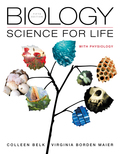
EBK BIOLOGY
5th Edition
ISBN: 8220101337627
Author: Maier
Publisher: PEARSON
expand_more
expand_more
format_list_bulleted
Concept explainers
Textbook Question
Chapter 13, Problem 7LTB
The mitochondria in a eukaryotic cell ___________.
- serve as the cell’s power plants;
- probably evolved from a prokaryotic ancestor;
- can live independently of the eukaryotic cell;
- A and B are correct;
- A, B, and C are correct
Expert Solution & Answer
Want to see the full answer?
Check out a sample textbook solution
Students have asked these similar questions
Both Prokaryotes and Eukaryotes have all of the
following except
O Cytoskeleton
O Ribosomes
Organelles
O DNA
This organelle is now thought to have been a prokaryote that gave up genes in order to live inside a
eukaryotic cell.
O golgi apparatus
O nucleus
mitochondrian
rough endoplasmic reticulum (ER)
Which eukaryotic organelle, if it is present, can synthesize ATP and other high-energy chemicals for the cell through photophosphorylation (in the presence of sunlight)?
the peroxisome
the chloroplast
the lysosome
the ribosome
the nucleus
Chapter 13 Solutions
EBK BIOLOGY
Ch. 13 - How many different species have been identified by...Ch. 13 - Plants experienced an adaptive radiation after the...Ch. 13 - How are hypotheses about the evolutionary...Ch. 13 - Which of the following kingdoms or domains is a...Ch. 13 - Comparisons of ribosomal RNA among many different...Ch. 13 - On examining cells under a microscope, you notice...Ch. 13 - The mitochondria in a eukaryotic cell ___________....Ch. 13 - Prob. 8LTBCh. 13 - Prob. 9LTBCh. 13 - Phylogenies are created based on the principle...
Additional Science Textbook Solutions
Find more solutions based on key concepts
Single penny tossed 20 times and counting heads and tails: Probability (prediction): _______/20 heads ________/...
Laboratory Manual For Human Anatomy & Physiology
Describe the role and impact of microbes on the earth.
Microbiology Fundamentals: A Clinical Approach
On what molecule does the anticodon appear? Explain the role of this molecule in protein synthesis.
Human Physiology: An Integrated Approach (8th Edition)
Give the IUPAC name for each compound.
Organic Chemistry
Why do scientists think that all forms of life on earth have a common origin?
Genetics: From Genes to Genomes
Knowledge Booster
Learn more about
Need a deep-dive on the concept behind this application? Look no further. Learn more about this topic, biology and related others by exploring similar questions and additional content below.Similar questions
- Identify the eukaryotic organelle that contains only one membrane, and a water soluble compartment for H2O2 and catalase enzymes, but no detectable DNA or RNA. the chloroplast the mitochondrion the lysosome the peroxisome the ribosomearrow_forwardThe mitochondria and chloroplast have small their own circular chromosomes, which is part of the evidence suggesting these organelles may have long ago been free-living prokaryotes that were brought into the cell in vesicles but not digested. True Falsearrow_forwardTrue or False Cell walls are present in the cells of archaea, bacteria, algae, fungi, and plants only. Photosynthetic unicellular prokaryotes such as Oscillatoria exhibit a green color when viewed under a microscope because of the presence of numerous chloroplasts. The nuclear membrane is a double-membrane structure that constitutes the outermost portion of the nucleus and is continuous with the Endoplasmic Reticulum.arrow_forward
- Identify the eukaryotic organelle that contains 2 membranes, a water soluble compartment for Krebs cycle enzymes, and a lipid soluble compartment for electron transport and oxidative phosphorylation. the chloroplast the mitochondrion the lysosome the peroxisome the ribosomearrow_forwardWhich eukaryotic organelle, if it is present, is generally the only one with three membranes (two of which are transparent to sunlight, and the third of which is green in color)? the peroxisome the lysosome the nucleus the ribosome the chloroplastarrow_forwardWhich of the following structures would never be found in a eukaryotic cell? Cell wall Cell membrane Nucleoid region Nucleolus Nucleusarrow_forward
- Which of the following is FALSE regarding the four structures that BOTH prokaryotic and eukaryotic cells have in common and why are these essential structures for all cells?1 DNA directs protein production2 Mitochondria the power house of the cell3 Cytoplasm, aqueous interior of all cell houses organelles and other structure 4 cell membrane : regulates movement of molecules between cell and its surroundings5 ribosome build proteins according to the DNA's instructionsarrow_forwardWhich eukaryotic organelle is covered by a single membrane, contains an acidic interior, and is important for intracellular digestion of proteins being brought into the cell by endosomes? the lysosome the mitochondrion the ribosome the peroxisome the nucleusarrow_forwardWhen the Golgi apparatus glycosylates a protein with the mannose-6-phosphate tag, this tag serves as a label for which of the following eukaryotic cell destinations? the mitochondria the lysosome the peroxisome the nucleus the chloroplastarrow_forward
- Which of the following eukaryotic structures is responsible for the production and synthesis of ATP? ribosomes Golgi bodies mitochondria nucleusarrow_forwardAll of the following are part of a prokaryotic cell except cell membrane ribosome Golgi apparatus chromosomearrow_forwardMitochondria and chloroplast have their own DNA and replicate separately from the nucleus and they can synthesize ATP. Can they survive outside of the cell? Explain. Gracias!arrow_forward
arrow_back_ios
SEE MORE QUESTIONS
arrow_forward_ios
Recommended textbooks for you
 Biology Today and Tomorrow without Physiology (Mi...BiologyISBN:9781305117396Author:Cecie Starr, Christine Evers, Lisa StarrPublisher:Cengage Learning
Biology Today and Tomorrow without Physiology (Mi...BiologyISBN:9781305117396Author:Cecie Starr, Christine Evers, Lisa StarrPublisher:Cengage Learning
 Biology: The Dynamic Science (MindTap Course List)BiologyISBN:9781305389892Author:Peter J. Russell, Paul E. Hertz, Beverly McMillanPublisher:Cengage Learning
Biology: The Dynamic Science (MindTap Course List)BiologyISBN:9781305389892Author:Peter J. Russell, Paul E. Hertz, Beverly McMillanPublisher:Cengage Learning Concepts of BiologyBiologyISBN:9781938168116Author:Samantha Fowler, Rebecca Roush, James WisePublisher:OpenStax College
Concepts of BiologyBiologyISBN:9781938168116Author:Samantha Fowler, Rebecca Roush, James WisePublisher:OpenStax College

Biology Today and Tomorrow without Physiology (Mi...
Biology
ISBN:9781305117396
Author:Cecie Starr, Christine Evers, Lisa Starr
Publisher:Cengage Learning


Biology: The Dynamic Science (MindTap Course List)
Biology
ISBN:9781305389892
Author:Peter J. Russell, Paul E. Hertz, Beverly McMillan
Publisher:Cengage Learning

Concepts of Biology
Biology
ISBN:9781938168116
Author:Samantha Fowler, Rebecca Roush, James Wise
Publisher:OpenStax College
Biology - Intro to Cell Structure - Quick Review!; Author: The Organic Chemistry Tutor;https://www.youtube.com/watch?v=vwAJ8ByQH2U;License: Standard youtube license